COMMITMENT TO GLOBALIZATION China has benefited greatly from globalization and continues to contribute to its development
By Hu Biliang
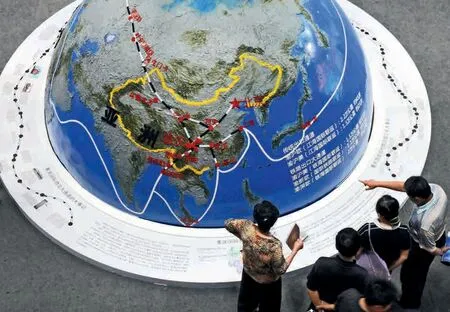
A globe display of Yuxin’ou(Chongqing-Xinjiang-Europe)International Railway at the 15th China Chongqing International Investment and Global Sourcing Fair (CCISF)at Chongqing International Expo Center on May 17,2012.
Today,globalization is poised at a crossroads.With the growth of the volume of world trade,foreign investment is widespread and the number of transnational corporations continues growing,yet the world economy is facing severe stability challenges that have created widespread worry and doubt.However,globalization remains an irreversible trend,and the tide of economic,trade and technological cooperation has not reversed.
Waves of Globalization
The globalization phenomenon is often traced historically back to the Age of Exploration and the Age of Discovery in the 15th Century.Several studies have concluded that globalization took place on a large scale even before that age.The Silk Road,for example,was an international trade route more than 2,000 years ago.Periodic waves of globalization have been widely recognized.

The first endeavor was the establishment of special economic zones. Beginning in 1979,China built special economic zones in Shenzhen,Zhuhai and Shantou in Guangdong Province and Xiamen in Fujian Province,followed by another in Hainan Province.China then opened 14 coastal cities to the world and built 15 integrated bonded areas while gradually opening its doors to the outside world.

The second endeavor was accession into the World Trade Organization (WTO).After 15 years of tough negotiations,China joined the WTO in 2001 and became immersed in global trade and investment rules comprehensively.Today,more than 400 of the Fortune Global 500 companies are investing in production in China,making the country the world’s most important production base.

The third move was development of pilot free trade zones.Since 2013,China has activated and advanced construction of 18 pilot free trade zones across the country.

The fourth was introduction of the Belt and Road Initiative. In 2013,Chinese President Xi Jinping introduced the initiative and encouraged Chinese companies to“go global.”The combination of“going global”and“bringing in (investment and technology)”has comprehensively integrated the Chinese economy with the world economy.
The first wave of large-scale globalization in recent history took place during the 150 years from mid-18th Century to late-19th Century.It featured largescale restructuring of the manufacturing industry driven by two industrial revolutions that resulted in a boom in international investment and trade.As a result,two major industrialized powers of the world emerged,driving the flow and allocation of production factors and products on a global scale.Statistics show that more than 150 countries and regions in the world were participating in various forms of international trade in 1913,and foreign direct investment (FDI) accounted for about 20 percent of GDP.
In 1914,World War I broke out,followed by the Great Depression and World War II.The first wave of large-scale globalization subsided.
The second wave of globalization started after World War II with the establishment of international institutions such as the United Nations,the International Monetary Fund and the World Bank that helped shape the stable post-WWII world economic order.Globalization entered the stage of rules and institutions within the framework of a global governance system.However,by the 1970s,the economic boom in major developed countries ended,causing the Bretton Woods system to finally collapse.The situation further deteriorated with the oil crisis,leading to the end of the second wave of globalization.

Chinese Minister of Foreign Trade and Economic Cooperation Shi Guangsheng (right)toasts World Trade Organization Director-General Mike Moore (left)at the signing ceremony of China’s accession into the WTO in Doha,Qatar,on November 11,2001.
The third wave of globalization began when Britain and the United States began vigorously promoting neoliberalism,privatization and liberalization,resulting in the global flow of capital,especially the heavy flow from developed countries to developing countries,which promoted another round of major adjustments in the global industrial layout and rapid development of international trade.The peak of the third wave arrived in the 1980s and 90s,marked by a large influx of international capital into developing countries,largescale transfer of industries into developing countries,substantial reduction in tariffs and a sharp decrease in non-tariff measures,until the 2008 financial crisis in the United States.
Opening Up to Globalization
For many reasons,China failed to actively participate in the first and second waves of globalization.After missing the opportunities of the first two waves of globalization,China began its reform and opening-up in 1978 just in time for the third wave.China has since played an active role in the process,from which it has benefited considerably,and contributed heavily.
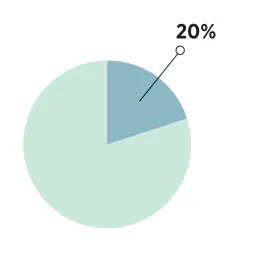
Statistics show that more than 150 countries and regions in the world were participating in various forms of international trade in 1913,and foreign direct investment(FDI) accounted for about 20 percent of GDP.
At the end of 1978,China began to implement new policies and strategies of reform and openingup.Based on the actual situation in the country,China succeeded in four major endeavors which resulted in promotion of both its own economic development and further development of globalization.
The first endeavor was the establishment of special economic zones.The establishment of such zones directly promoted the large-scale flow of global capital into China and the relocation of global industries to China,improving the efficiency of production and allocation of global products.Beginning in 1979,China built special economic zones in Shenzhen,Zhuhai and Shantou in Guangdong Province and Xiamen in Fujian Province,followed by another in Hainan Province.China then opened 14 coastal cities to the world and built 15 integrated bonded areas while gradually opening its doors to the outside world.

A Volvo is offloaded from a container arriving via the China-Europe Railway Express in Zeebrugge,Belgium on June 30,2017.
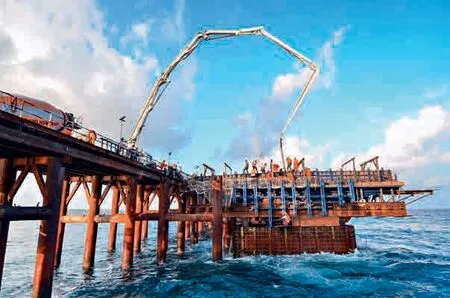
The first pier shaft of the China-Maldives Friendship Bridge,a major project of the 21st Century Maritime Silk Road,is successfully cemented on April 21,2017.
The second endeavor was accession into the World Trade Organization (WTO).After 15 years of tough negotiations,China joined the WTO in 2001 and became immersed in global trade and investment rules comprehensively.As an important link of the global product chain and value chain,China has attracted an increasing volume of foreign investment.Today,more than 400 of the Fortune Global 500 companies are investing in production in China,making the country the world’s most important production base.
The third move was development of pilot free trade zones.Since 2013,China has activated and advanced construction of 18 pilot free trade zones across the country.By significantly reducing tariffs,opening markets and improving the business environment,it has created better conditions for the flow of global economic factors into China.
The fourth was introduction of the Belt and Road Initiative.In 2013,Chinese President Xi Jinping introduced the initiative and encouraged Chinese companies to“go global.”The combination of“going global”and“bringing in(investment and technology)”has comprehensively integrated the Chinese economy with the world economy.
Beneficiary &Contributor
Not only has China benefited from globalization,the country has also contributed significantly to its development.
How has China benefited from globalization?
First,the heavy flow of foreign capital into China helped the country meet the needs for an economic take-off resulting in positive momentum that continues to this day.Since China became more active in globalization,it has attracted an increasing number of foreignfunded enterprises as well as an increasing amount of foreign investment.In 1980,only seven foreign-funded enterprises were registered in China,and five years late the number had jumped to 5,000.By 2018,more than 900,000 foreign-funded enterprises had invested in China.In 1983,China’s applied foreign investment was a mere US$2.3 billion,which grew to US$135 billion in 2018.More than US$2 trillion of foreign direct investment was used across 40 years.
Second,globalization has promoted the rapid growth of China’s foreign trade.In 1978,China’s total foreign trade was only US$20.6 billion,which increased to US$4.62 trillion by 2018—a 200-fold increase in 40 years with an average annual growth rate of more than 14 percent.China has been the world’s biggest trader of goods for several years running.
Third,in terms of the balance of payments,China’s international income balance has improved as a result of the massive flow of foreign capital into the country and the continuing surplus of trade in goods.Since 1994,China has enjoyed a long-term current account surplus as well as a capital account surplus for more than 20 years,contributing to the continuous growth of the country’s foreign exchange reserves from US$170 million in 1978 to over US$3 trillion at present.
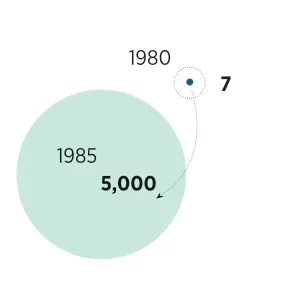
In 1980,only seven foreign-funded enterprises were registered in China,and five years late the number had jumped to 5,000.
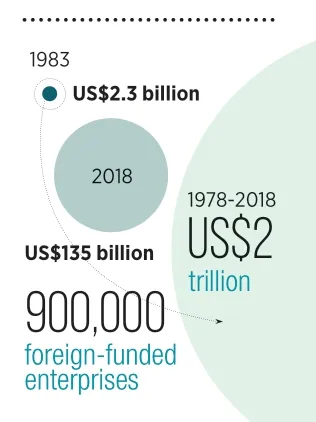
By 2018,more than 900,000 foreignfunded enterprises had invested in China.In 1983,China’s applied foreign investment was a mere US$2.3 billion,which grew to US$135 billion in 2018.More than US$2 trillion of foreign direct investment was used across 40 years.
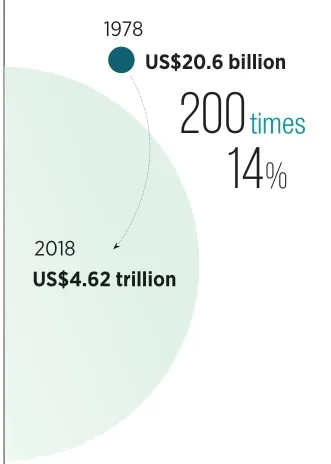
In 1978,China’s total foreign trade was only US$20.6 billion,which increased to US$4.62 trillion by 2018—a 200-fold increase in 40 years with an average annual growth rate of more than 14 percent.
Finally,the inflow of foreign capital and the development of capital have directly promoted the rapid growth of the Chinese economy.In the 40 years from 1978 to 2018,China’s GDP maintained an average annual growth rate of 9.4 percent in real terms.Shenzhen,a pioneer of reform and opening-up,maintained an annual nominal growth rate of 25 percent for 40 years.At the beginning of reform and opening-up,the city’s annual nominal growth rate reached as high as 50.3 percent while the national average was only 13 percent.
What contributions has China made to globalization?
First,China has imported considerable goods and services from countries and regions around the world,contributing to outside economic growth and employment opportunities.In 1978,China’s imports of goods measured a mere US$10.9 billion,which increased to US$2.1 trillion in 2018.Since 2009,China has been the world’s second largest importer.
Second,at the early stage of reform and opening-up,China wielded hardly any outbound investment.But in recent years,it has invested more than US$100 billion in overseas markets annually.Since the introduction of the Belt and Road Initiative,China’s outbound investment has increased significantly,eventually surpassing inbound investment for the first time in 2014.By 2018,China had established 43,000 FDI enterprises in 188 countries and regions around the world,over 10,000 of which were in countries and regions along the Belt and Road.Chinese investment has reached more than 80 percent of countries and regions in the world.In 2018,China’s outbound direct investment reached US$143 billion,accounting for 14.1 percent of global FDI flow,slightly lower than Japan,making it the second largest foreign investor in the world.By 2018,China’s outbound investment stock reached US$1.98 trillion,the world’s third largest after the United States and the Netherlands,which contributed greatly to economic development in relevant countries.
Third,Chinese companies investing abroad paid a total of US$59.4 billion in taxes to host countries in 2018.
Fourth,Chinese companies abroad employ about 1.88 million foreign employees,accounting for more than half of their overseas employees.
Driving Force in the New Era
While entering the new era,China has implemented a series of policies and measures to more proactively promote reform and opening-up and contribute even more to globalization.As the largest developing country with the largest population,the second largest economy,the largest middle class,the largest manufacturing industry and the largest-scale trade in goods,China is a huge market for every country.
China should continue to contribute to globalization with a positive attitude and promote common development around the world.In the current circumstances,China should promote globalization in the new era several ways:
First,China should make better use of the Belt and Road international cooperation platform for quality development to bring more tangible benefits to people in all countries and lay a solid foundation for a community with a shared future for mankind.
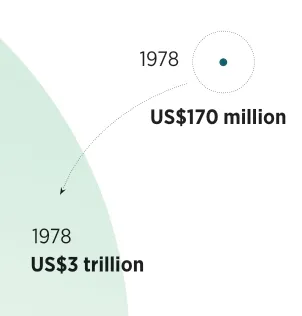
Since 1994,China has enjoyed a long-term current account surplus as well as a capital account surplus for more than 20 years,contributing to the continuous growth of the country’s foreign exchange reserves from US$170 million in 1978 to over US$3 trillion at present.
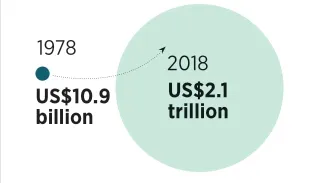
In 1978,China’s imports of goods measured a mere US$10.9 billion,which increased to US$2.1 trillion in 2018.
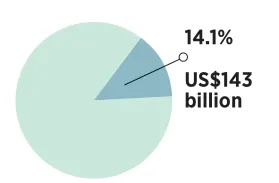
In 2018,China’s outbound direct investment reached US$143 billion,accounting for 14.1 percent of global FDI flow,slightly lower than Japan,making it the second largest foreign investor in the world.
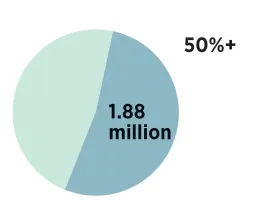
Chinese companies abroad employ about 1.88 million foreign employees,accounting for more than half of their overseas employees.
Second,China should optimize the usage of domestic and international resources to jointly build the Guangdong-Hong Kong-Macao Greater Bay Area.This bay area is international in nature,belonging to both China and the world.Forging a new international platform with world-class talents and cuttingedge technology and equipment to foster common and open development has become an essential task.
Third,China should further promote development of pilot free trade zones.Additional zones of higher quality should be built to promote China’s highquality opening-up and create an improved international cooperation platform for further globalization development.
Fourth,China must deepen reform of trade and investment.In terms of trade,China should provide solutions for WTO reform and shaping a strong,fair,and sustainable global trade system.In terms of investment,China has updated the Foreign Investment Law of the People’s Republic of China,a move that demonstrates China’s continuing improvement in this regard.
Fifth,China should further promote opening of the financial sector.In July 2019,China’s State Council announced 11 new measures to further open the financial sector across areas ranging from the bond market,banks and insurance companies to retirement pensions.More needs to be done in this regard.
- China Report Asean的其它文章
- SHARING REAL CHINA A journey of discovery by mainstream ASEAN media
- News in Brief
- AN EYE FOR QUALITY Singles’Day shopping offers a peek into China’s consumption upgrade
- LIFE POWERED BY TECH Innovation leads the consumption upgrade in China
- CHINA CAN EMERGE AS A MODERN COUNTRY WITH GLOBAL INFLUENCE Decoding Chinese governance through a British academic
- ETERNAL CHINA-BRUNEI FRIENDSHIP Interview with Ambassador Yu Hong

